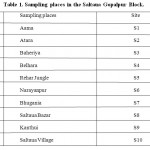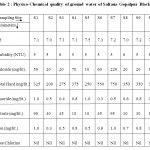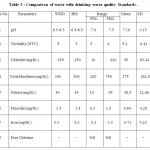Assessment of Groundwater Quality in Saltaua Gopalpur Block of Basti District, (U.P.) India
R.V. Prasad1 * , D.R. Tripathi1 and Vinod Kumar2
1
Department of Chemistry,
Kisan P.G. College Babhnan,
Gonda,
U.P.
India
2
Department of Zoology,
Kisan P.G. College Babhnan,
Gonda,
U.P.
India
DOI: http://dx.doi.org/10.12944/CWE.8.3.20
Copy the following to cite this article:
Prasad R. V, Tripathi D. R, Kumar V. Assessment of Groundwater Quality in Saltaua Gopalpur Block of Basti District, (U.P.) India. Curr World Environ 2013;8(3) DOI:http://dx.doi.org/10.12944/CWE.8.3.20
Copy the following to cite this URL:
Prasad R. V, Tripathi D. R, Kumar V. Assessment of Groundwater Quality in Saltaua Gopalpur Block of Basti District, (U.P.) India. Curr World Environ 2013;8(3). Available from: http://www.cwejournal.org/?p=5099
Download article (pdf)
Citation Manager
Publish History
Select type of program for download
| Endnote EndNote format (Mac & Win) | |
| Reference Manager Ris format (Win only) | |
| Procite Ris format (Win only) | |
| Medlars Format | |
| RefWorks Format RefWorks format (Mac & Win) | |
| BibTex Format BibTex format (Mac & Win) |
Article Publishing History
| Received: | 2013-08-08 |
|---|---|
| Accepted: | 2013-09-30 |
Introduction
Water is a one of the most important renewable natural resources. Approximately 71% of the earth’s surface is covered with water. Fresh water is found as underground water in large reservoirs surrounded by rock called aquifers. This ground water has long been considered is one of the purest forms of water available in nature to meet the overall demand of rural and semi urban people.1 In India most of the population is dependent on ground water as it is the only source of drinking water supply.2 The quality of ground water is the resultant of all the processes and reaction that act on the water from the moment it condensed in the atmosphere to the time it is discharged by a well as spring and varies from place to place and with the depth of the water table.3
Considering the above aspects an attempt has been made under the present study to assess the physic-chemical properties of ground water in Saltaua Gopalpur block of Basti district.
Material and Methods
Study Site
Saltaua Gopalpur block is situated in the north part of the district Basti. It is 15 km. away from the district head quarter . It has a geographical area of 216.90 km2, it is bounded by 26.81 oN latitude an 82.76 oE longitude, The normal annual rain fall varies from1050 mm to 1200 mm.
Sample Collection
A total 10 samples from different place which were minimum 2-3 km between one and another location was maintained in order to carry out a broad study on the quality of water in this area. The sample collection area has been assigned as sample points.
The sample was collected in plastic bottles which one cleaned with acid water, followed by rinsing twice with distilled water. The analysis of water was done by using Himedia water testing kit.
 |
Table 1: Sampling places in the Saltaua Gopalpur Block. Click here to View table |
Result and Discussion
The examined various physico-chemical parameters showed considerable variations in different samples. The observations are depicted in table-2.The findings and their comparison with WHO13 and BIS14 health based drinking guidlines are Presented in table3. The data revealed a considerable variation in the water samples with respect to their chemical composition.
pH is affected not only by the reaction of carbon dioxide but also by organic and inorganic solute present in water. Any alteration in water pH is accompanied by the change in other physico-chemical parameters .15 pH Varies from 7.0to 7.5. This shows that all samples are existed within the minimum and maximum tolerable limit of WHO and BIS. The water sample were found to be slightly basic in nature.16-18
The turbidity varies from 5-6 NTU. This shows that most of the samples are existed within Permissible limit of WHO & BIS.
Chloride varies from 10-220 mg/lit. All the water samples are under the permissible limits as of WHO.19-20 Chloride is not harmful to human at low concentration but could alter the taste of water at concentration above 250mg/lit.21
Hardness is very important in decreasing the toxic effect of poisonous element.22 Hardness is measured in terms of total hardness and calcium hardness. Total hardness varies form 200-750 mg/lit mostly exceeds the maximum permissible limits of WHO.22-25 Hardness although has no health effects it can make water unsuitable for domestic and industrial use.1
 |
Table 2: Physico-Chemical quality of ground water of Saltaua Gopalpur Block. Click here to View table |
Nitrate varies from 10-95 mg/lit. Although only two samples S1 and S7 exceeds the permissible limit and shows high concentration.20 Nitrate Indicates the pollution in ground water due to agricultural activities, sewage percolation beneath the surface.22,26,27 Presence of nitrate in water indicates the final stage of mineralization.28
The major natural resource of fluoride is amphiboles, apatite, fluorite and mica. It’s concentration in natural waters generally should not exceed 10mg/lit.1 The factor responsible for ground water contamination with fluoride are geological factors such as weathering of minerals, rock dissolution and decomposition Containing fluoride over a long period of time resulting in the leaching it into ground water.4 An anthropogenic factor such as industrial proces liberates higher concentration of fluoride into atmosphere.
The concentration of fluoride in the studied Water samples varies from 0.3 to 1.0mg/lit.20 High fluoride concentration causes dental fluorosis and more skeletal fluorosis29 whereas the low concentration or absence of fluoride in drinking water results in dental caries in children particularly when the fluoride concentration is less than 0.5 mg/lit .30
 |
Table 3: Comparison of water with drinking water quality Standards. Click here to View table |
The values of iron in study area varies from 0.3 to 1.0 mg/lit. Which are higher than the tolerable value except sample S6. This may be due to soil origin and age old iron pipes used in the area.16,31 The storage of iron causes a diseases called “anaemia” and prolonged consumption of drinking water with high concentration of iron may be lead to liver diseases called as haemosiderosis.
The free chlorine was found to be absent in all the samples.
Conclusion
The analysis of the physico-chemical parameters of ground water from ten different locations in Saltaua Gopalpur block shows that the pH, turbidity, chloride and fluoride were within permissible limit. Highly exceeded value of total hardness, nitrate and iron were reported at some locations of study area. The observed standard deviation for the parameters shows that the deviation in the total hardness (162.02), chloride (63.42) and nitrate (32.06) are of moderately high range. From this it is concluded that various parameter concentration are varying highly in different location of Saltaua Gopalpur block.
Acknowledgments
The authors are thankful to Dr. Ram Prasad Ex-vice chancellor, Barkatullah University, Bhopal (M.P.), for providing academic inputs. Also thankful to Dr. T.A. Qureshi, (Ex.H.O.D) Deptt. Of Applied Aquaculture, Barkatullah, University, Bhopal,M.P. and to Prof. V.B. Upadhayay, D.D.U. Gorakhpur University, Gorakhpur (U.P. ), for their valuable suggestions.
References
- Nirmala B., Suresh Kumar B.V., Suchetan P.A. and Shetprakash M., seasonal variations of Physico –chemical characteristics of ground water sample of Mysore city, Karnataka, India. Int. J. Env.sci.,vol.1(4),43-49, Nov. (2012).
- Agrawal R, Physico -chemical analysis of some ground water samples of Kotputil town Jaipur ,Rajasthan . Int. J.che. Env. Pharm. Res., Rajasthan,vol.(2),111-113,(2010).
- Shyamala R., Santhi M. and Lalitha P., Physico-chemical analysis of borwell water samples of Telungupalayam area in Coimbatore District, Tamilnadu, India.E.J. Chemistry,vol. 5(4),924-927(2008).
- Jamal A.A., Physico –chemical studies in Uyyakondan channel water of river Cavery., Poll.Res .,vol.17(2),111(1998).
- Murhekar G.H., Determination of physic -chemical parameters of surface water sample in and around Akot city, Int.J.Res.chem.Env.Vol.1(2),183-187 (2011).
- Singh V.,Physico-chemical examination of water, sewage and Industrial effluents, Res.J.Chem.and Env.Vol.10(3),62-66(2006).
- Mishra A. and Bhatt V., Physico-chemical and Microbiological analysis of under ground water in V.V. Nagar and Nearby Places of Anand District, Gujarat, India. E-J chem. ,vol.5(3),487-492(2008).
- Desi P.V.,water auality of Dudhsagar river at Dudhasagar, Goa,India. Poll.Res.,vol.4,377-382(1995).
- Elizabeth K.M.and Naik P.L.,Effect of polluted water on human health,Poll.Res.,Vol 24(2), 337 (2005).
- Muller E.E, Ethlers M.M. and Grabow, The occurrence of E. coli. 0157:H7 in South Africa water sources intended for direct and indirect human consumption, water Res., vol 35,3085-3088 (2001).
- Aremu M.O., Gav,B.L., Opaluwa O.D., Atolaiya B.O., Madu P.C. and Sangari D.U., Assessment of physico-chemical contaminants in waters and Fishes from selected rivers in Nasarawa State, Nigeria. Res.J. Chem.Sci., vol. (4), 6-17 (2011).
- Shama S., Iffat N., Mohammad I.A.and Safia A., Monitoring of physic -chemical and microbiological analysis of under ground water sample of district Kallar Syedan, Rawalpindi-Pakistan. Res. J.Chemi.Sci., Vol.1 (8) , 24-30 (2011).
- WHO, International Standard for drinking water,3rd ed, Geneva,(2008).
- BIS, Specification for drinking water. Bureau of Indian Standards, New Delhi, 171-178
- Wetzel R.G., Limnology, W.B. Saunders Co.,Philadelphia. USA, 743 (1975).
- Behra B., Das M. and Rana G.S., Studies on ground water pollution due to iron content and water quality in and around Jagdalpur, Bustar District, Chattisgarh, India. J. chem. Pharma Res., Vol.4 (8),3803-3807 (2012).
- Dharmaraja J., Vadivel S. and Ganesh Karthick E., Physico -chemical analysis of ground water samples of selected district of Tamilnadu and Kerala. Int.J. Scint. Tech. Res, Vol.1(5). 92-95 (2012).
- Parihar S.S., Kumar A., Kumar A., Gupta R.N., Pathak M., Shrivastav A. and Pandey A.C., Physico-chemical and microbiological analysis of under ground water in and around Gwalior city., M.P., India. Res.J.Recent sci.,vol.1(6),62-65(2012).
- Bundela P.S.,Sharma. A,Pandey A.K., Pandey P. and Awasthi A.K., Physico-chemical analysis of ground water near municipal solid waste dumping sites in Jabalpur ,M.P.India. Int,J. Plant, animal Env. Sci.vol.2 (1), 217-222 (2012).
- Arya S., Kumar V., Minakshi and Dhaka A., Assessment of underground water quality : A case study.of Jhansi city,U.P.India. Int. Multidis. .Res.J.,vol.1 (7),11-14(2011).
- Hauser B.A., Drinking water chemistry : A Laboratory manual. Lewis Publishers, A CRC Press company : Boca Raton, FL.,71(2001).
- Rajankar P.N, Wate S.R., Tambekar D.H. and Gulhane. S.R., Assessment of ground Water Quality using water auality Index (WQI) in wardha district. J. Env. Sci. sustaina., vol.1(2),49-54(2013).
- Meenakshi, Garg V.K, Kavita, Renuka and Malik A., Ground water quality in some villages of Haryana, India : focus on fluoride and fluorosis. J.Hazar.Mater,106B,85-97(2004).
- Veeraputhiran V. and Alagumuthu G., A report on fluoride distribution in drinking water, Int.J. Env.Sci., Vol.1 (4), 558-566 (2010).
- Poonam, Kumar R. and Yadav A., Ground water quality in Mohenderagarh Town, Haryana, India. Int.J. Pharm. Chem.Sci, vol.2 (1), 226-228 (2013).
- Jawad A, Shereideh A.L., Abu S.A., Rukah. Y.and Al Qadat K., Aquifer ground water quality. Science of the total Environment, 128, 69-81 (1998).
- Taiwo A.M., Adeogn A.O., Olatunde K.A. and Adegbite K.I., Analysis of ground water quality of hand dug wells in peri-urban area of Obantoko, Abeokuta for selected physic -chemical parameters. Pecific J. Sci Tech., vol.12 (1) 527-534 (2011).
- Nema P., Rajgopalan S. and Mehta C.G., Quality and treatment of Sabarmati river water Ahmedabad , J.I. w.w.A., Vol.16(1), 99-107 (1984).
- Ravindra K. and Garg V.K., Appraisal of ground water quality for drinking purpose in Hisar city (India) with special reference to fluoride. Int. J. Env. Hlt. Res, in press (2005).
- Patil N., Ahmed A., Sureshbabu H., Kottureshwar N.M., Jayashree M. and Nijalingappa J., Study on the physico -chemical characteristics of ground water of Gulbarga city, Karnataka, India. Int.J. Appli. Biopharm. Tech., Vol. 1 (2), 518-523 (2010).
- Rajgopal, Ground water quality assessment for public policy in India. 1st annual report, Deptt. of Geography, IOWA University, IOWA, 10-11 (1984).






